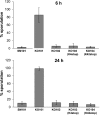Unique regulatory mechanism of sporulation and enterotoxin production in Clostridium perfringens
- PMID: 23585540
- PMCID: PMC3697249
- DOI: 10.1128/JB.02152-12
Unique regulatory mechanism of sporulation and enterotoxin production in Clostridium perfringens
Abstract
Clostridium perfringens causes gas gangrene and gastrointestinal (GI) diseases in humans. The most common cause of C. perfringens-associated food poisoning is the consumption of C. perfringens vegetative cells followed by sporulation and production of enterotoxin in the gut. Despite the importance of spore formation in C. perfringens pathogenesis, the details of the regulation of sporulation have not yet been defined fully. In this study, microarray and bioinformatic analyses identified a candidate gene (the RNA regulator virX) for the repression of genes encoding positive regulators (Spo0A and sigma factors) of C. perfringens sporulation. A virX mutant constructed in the food poisoning strain SM101 had a much higher sporulation efficiency than that of the wild type. The transcription of sigE, sigF, and sigK was strongly induced at 2.5 h of culture of the virX mutant. Moreover, the transcription of the enterotoxin gene was also strongly induced in the virX mutant. Western blotting confirmed that the levels of enterotoxin production were higher in the virX mutant than in the wild type. These observations indicated that the higher levels of sporulation and enterotoxin production in the virX mutant were specifically due to inactivation of the virX gene. Since virX homologues were not found in any Bacillus species but were present in other clostridial species, our findings identify further differences in the regulation of sporulation between Bacillus and certain Clostridium species. The virX RNA regulator plays a key role in the drastic shift in lifestyle of the anaerobic flesh eater C. perfringens between the vegetative state (for gas gangrene) and the sporulating state (for food poisoning).
Figures




Similar articles
-
Clostridium perfringens Sporulation and Sporulation-Associated Toxin Production.Microbiol Spectr. 2016 Jun;4(3):10.1128/microbiolspec.TBS-0022-2015. doi: 10.1128/microbiolspec.TBS-0022-2015. Microbiol Spectr. 2016. PMID: 27337447 Free PMC article. Review.
-
Identification of an Important Orphan Histidine Kinase for the Initiation of Sporulation and Enterotoxin Production by Clostridium perfringens Type F Strain SM101.mBio. 2019 Jan 22;10(1):e02674-18. doi: 10.1128/mBio.02674-18. mBio. 2019. PMID: 30670619 Free PMC article.
-
Evaluating the involvement of alternative sigma factors SigF and SigG in Clostridium perfringens sporulation and enterotoxin synthesis.Infect Immun. 2010 Oct;78(10):4286-93. doi: 10.1128/IAI.00528-10. Epub 2010 Jul 19. Infect Immun. 2010. PMID: 20643850 Free PMC article.
-
The CcpA protein is necessary for efficient sporulation and enterotoxin gene (cpe) regulation in Clostridium perfringens.J Bacteriol. 2004 Aug;186(16):5221-9. doi: 10.1128/JB.186.16.5221-5229.2004. J Bacteriol. 2004. PMID: 15292123 Free PMC article.
-
The Clostridium sporulation programs: diversity and preservation of endospore differentiation.Microbiol Mol Biol Rev. 2015 Mar;79(1):19-37. doi: 10.1128/MMBR.00025-14. Microbiol Mol Biol Rev. 2015. PMID: 25631287 Free PMC article. Review.
Cited by
-
Pathogenicity and virulence of Clostridium perfringens.Virulence. 2021 Dec;12(1):723-753. doi: 10.1080/21505594.2021.1886777. Virulence. 2021. PMID: 33843463 Free PMC article.
-
Small regulatory RNAs from low-GC Gram-positive bacteria.RNA Biol. 2014;11(5):443-56. doi: 10.4161/rna.28036. Epub 2014 Feb 10. RNA Biol. 2014. PMID: 24576839 Free PMC article. Review.
-
The Mechanisms of Virulence Regulation by Small Noncoding RNAs in Low GC Gram-Positive Pathogens.Int J Mol Sci. 2015 Dec 14;16(12):29797-814. doi: 10.3390/ijms161226194. Int J Mol Sci. 2015. PMID: 26694351 Free PMC article. Review.
-
Clostridium perfringens Sporulation and Sporulation-Associated Toxin Production.Microbiol Spectr. 2016 Jun;4(3):10.1128/microbiolspec.TBS-0022-2015. doi: 10.1128/microbiolspec.TBS-0022-2015. Microbiol Spectr. 2016. PMID: 27337447 Free PMC article. Review.
-
Regulation of Toxin Production in Clostridium perfringens.Toxins (Basel). 2016 Jul 5;8(7):207. doi: 10.3390/toxins8070207. Toxins (Basel). 2016. PMID: 27399773 Free PMC article. Review.
References
-
- Petit L, Gibert M, Popoff MR. 1999. Clostridium perfringens: toxinotype and genotype. Trends Microbiol. 7:104–110 - PubMed
-
- McClane BA. 2007. Clostridium perfringens, p 423–444 In Doyle MP, Beuchat LR. (ed), Food microbiology: fundamentals and frontiers, 3rd ed ASM Press, Washington, DC
-
- Stragier P. 2002. A gene odyssey: exploring the genomes of endospore-forming bacteria, p 519–525 In Sonenshein AL, Hoch JA, Losick R. (ed), Bacillus subtilis and its closest relatives: from genes to cells. American Society for Microbiology, Washington, DC
Publication types
MeSH terms
Substances
LinkOut - more resources
Full Text Sources
Other Literature Sources
Molecular Biology Databases

